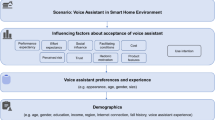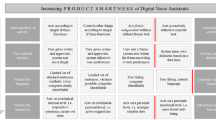Abstract
The rapid development of artificial intelligence technology has made a variety of smart voice assistant products manufactured and widely used. Nevertheless, the influence of the design features of smart voice assistants on user acceptance is relatively vague. This study aimed to identify the design features that are critical to the acceptance of smart voice assistants by users. A questionnaire was designed and constructed. A total of 220 subjects participated in this survey. User acceptance is measured with perceived ease of use (PEOU), perceived usefulness (PU), attitude (AT) and intention to use (IU). Results showed that PU was significantly associated with smart voice assistant gender and PEOU. AT was significantly related to content diversity, personification, PEOU, and PU. IU was significantly related to sound quality, PU, and AT. The proposed model comprising demographic variables, design features, and acceptance-related variables could explain 49.3% of the variance in IU.
Access this chapter
Tax calculation will be finalised at checkout
Purchases are for personal use only
Similar content being viewed by others
References
Dousay, T.A., Hall, C.: Alexa, tell me about using a virtual assistant in the classroom. In: EdMedia + Innovate Learning, pp. 1413–1419. Association for the Advancement of Computing in Education (AACE) (2018)
Yang, H., Lee, H.: Understanding user behavior of virtual personal assistant devices. Inf. Syst. e-Bus. Manag. 17(1), 65–87 (2018). https://doi.org/10.1007/s10257-018-0375-1
Han, S.H., Yun, M.H., Kim, K.J., Kwahk, J.: Evaluation of product usability: development and validation of usability dimensions and design elements based on empirical models. Int. J. Ind. Ergon. 26(4), 477–488 (2000)
Beldad, A., Hegner, S., Hoppen, J.: The effect of virtual sales agent (VSA) gender – product gender congruence on product advice credibility, trust in VSA and online vendor, and purchase intention. Comput. Hum. Behav. 60, 62–72 (2016). https://doi.org/10.1016/j.chb.2016.02.046
Ludewig, Y., Döring, N., Exner, N: Design and evaluation of the personality trait extraversion of a shopping robot. In: The 21st IEEE International Symposium on Robot and Human Interactive Communication, Paris, France, pp. 372–379. IEEE (2012)
Elkins, A., Derrick, D.: The sound of trust: voice as a measurement of trust during interactions with embodied conversational agents. Group Decis. Negot. 22(5), 897–913 (2013)
Aiello, J.R., Douthitt, E.A.: Social facilitation from Triplett to electronic performance monitoring. Group Dyn. Theory Res. Pract. 5(3), 163–180 (2001)
Chiou, E.K., Schroeder, N.L., Craig, S.D.: How we trust, perceive, and learn from virtual humans: the influence of voice quality. Comput. Educ. 146, 103756 (2020)
Komiak, S.Y., Benbasat, I.: The effects of personalization and familiarity on trust and adoption of recommendation agents. MIS Q. 30(4), 941–960 (2006)
Craig, S.D., Schroeder, N.L.: Reconsidering the voice effect when learning from a virtual human. Comput. Educ. 114, 193–205 (2017)
Saad, U., Afzal, U., El-Issawi, A., Eid, M.: A model to measure QoE for virtual personal assistant. Multimed. Tools Appl. 76(10), 12517–12537 (2016). https://doi.org/10.1007/s11042-016-3650-5
Chattaraman, V., Kwon, W.S., Gilbert, J.E., Ross, K.: Should AI-Based, conversational digital assistants employ social- or task-oriented interaction style? A task-competency and reciprocity perspective for older adults. Comput. Hum. Behav. 90, 315–330 (2019)
Moreno, R., Mayer, R.E.: Personalized messages that promote science learning in virtual environments. J. Educ. Psychol. 96(1), 165–173 (2004)
Shiban, Y., Schelhorn, I., Jobst, V., et al.: The appearance effect: influences of virtual agent features on performance and motivation. Comput. Hum. Behav. 49, 5–11 (2015)
Fishbein, M., Ajzen, I.: Belief, Attitude, Intention and Behavior: An Introduction to Theory and Research. Addison-Wesley, Massachusetts (1975)
Ajzen, I.: The theory of planned behavior. Organ. Behav. Hum. Decis. Process. 50(2), 179–211 (1991)
Davis, F.D., Bagozzi, R.P., Warshaw, P.R.: User acceptance of computer technology: a comparison of two theoretical models. Manag. Sci. 35(8), 982–1003 (1989)
Rogers, E.M.: Diffusion of Innovations, 4th edn. Etats-Unis Free Press, New York (1995)
Venkatesh, V., Morris, M.G., Davis, G.B., Davis, F.D.: User acceptance of information technology: Toward a unified view. MIS Q. 27(3), 425–478 (2003)
Zhang, T., Rau, P.L.P., Salvendy, G.: Exploring critical usability factors for handsets. Behav. Inf. Technol. 29(1), 45–55 (2010)
Kleijnen, M., Wetzels, M., de Ruyter, K.: Consumer acceptance of wireless finance. J. Finan. Serv. Mark. 8(3), 206–217 (2004)
Davis, F.D.: Perceived usefulness, perceived ease of use, and user acceptance of information technology. MIS Q. 319–340 (1989)
Cameron, D.: Styling the worker: gender and the commodification of language in the globalized service economy. J. Sociolinguistics 4(3), 323–347 (2000)
Sparks, B.A., Bradley, G.L., Callan, V.J.: The impact of staff empowerment and communication style on customer evaluations: the special case of service failure. Psychol. Mark. 14(5), 475–493 (1997)
Beldad, A., Hegner, S., Hoppen, J.: The effect of virtual sales agent (VSA) gender–product gender congruence on product advice credibility, trust in VSA and online vendor, and purchase intention. Comput. Hum. Behav. 60, 62–72 (2016)
Acknowledgements
This work was supported by grants from Natural Science Foundation of China (Project No. 71901033) and Beijing Natural Science Foundation (Project No. 9204029).
Author information
Authors and Affiliations
Corresponding author
Editor information
Editors and Affiliations
Rights and permissions
Copyright information
© 2021 Springer Nature Switzerland AG
About this paper
Cite this paper
Liu, N., Liu, R., Li, W. (2021). Identifying Design Feature Factors Critical to Acceptance of Smart Voice Assistant. In: Rau, PL.P. (eds) Cross-Cultural Design. Applications in Cultural Heritage, Tourism, Autonomous Vehicles, and Intelligent Agents. HCII 2021. Lecture Notes in Computer Science(), vol 12773. Springer, Cham. https://doi.org/10.1007/978-3-030-77080-8_30
Download citation
DOI: https://doi.org/10.1007/978-3-030-77080-8_30
Published:
Publisher Name: Springer, Cham
Print ISBN: 978-3-030-77079-2
Online ISBN: 978-3-030-77080-8
eBook Packages: Computer ScienceComputer Science (R0)




